When it comes to fluttering, nectar-sucking backyard insects, butterflies tend to get all the attention. Sure, they’re very pretty, but did you know their nocturnal cousins can be just as spectacular to see?
Let’s put moths in the spotlight for once! You might be surprised by how many gorgeous species could be overlooked (or mistaken for butterflies) in your very own garden.
First, is it a moth or a butterfly?
Some moths are so large and vibrant that it’s hard to tell them apart from butterflies. Some are also diurnal, so they fly around at the same time as butterflies, drinking nectar from the same types of flowers while pollinating your garden. Yep, they’re actually highly underestimated pollinators! (And moths have other benefits in your yard too.)
You can usually discern one from the other by looking at a few key characteristics:
| Moths | Butterflies | |
|---|---|---|
| Antennae | Thick, feathery, comb-like | Thin, straight, long with club-like tips |
| Bodies | Fuzzy and stocky | Smooth and lean |
| At rest | Hold their wings horizontally | Fold their wings over their backs |
These are just generalizations, however, as there are definitely exceptions, especially in other parts of the world.
(Also be sure to check out my guides on identifying green caterpillars and striped caterpillars; many of them transform into the moths described here.)
16 beautiful garden moth species
Luna moth (Actias luna)
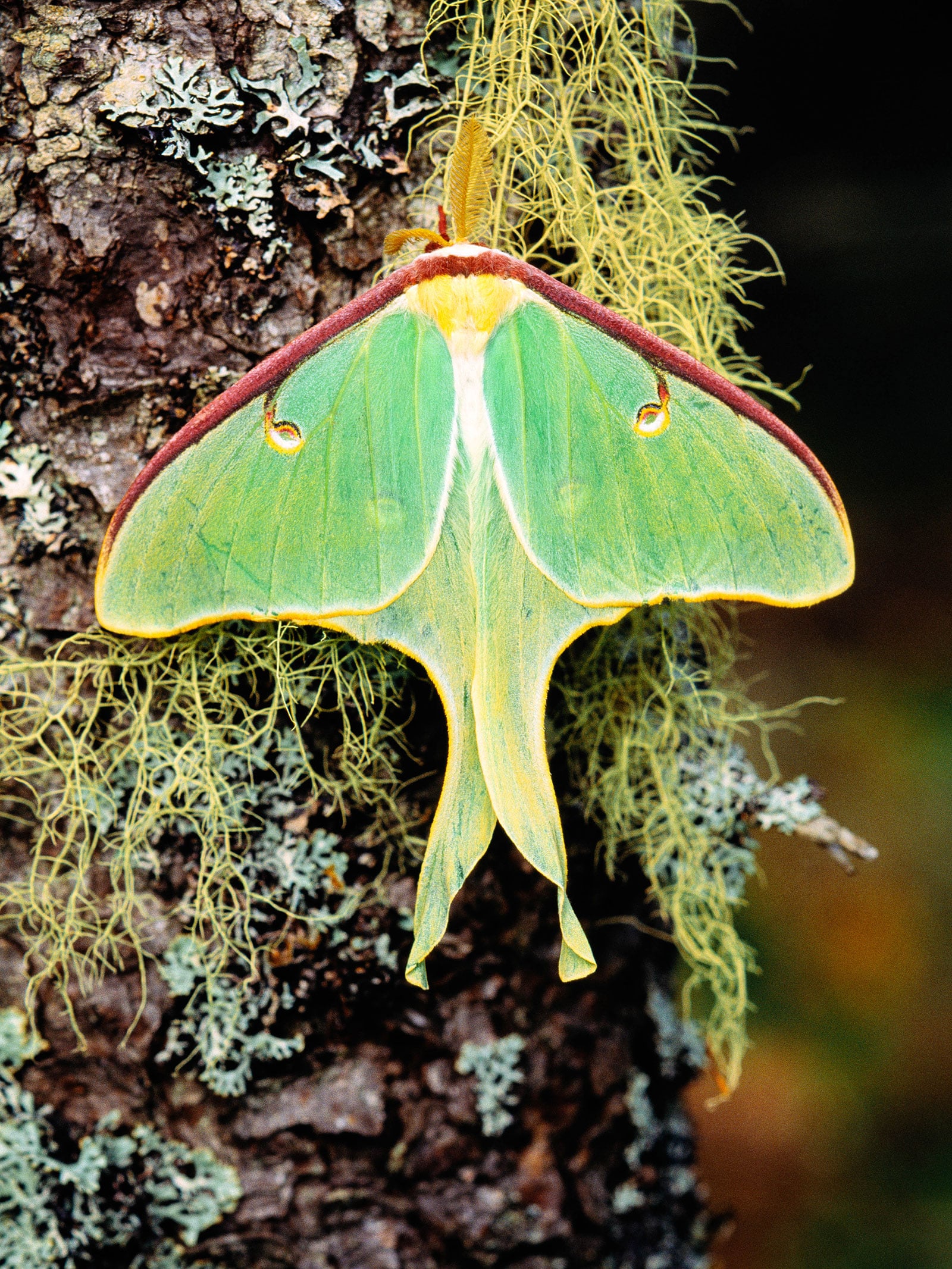
When it comes to pretty moths in North America, the luna moth (Actias luna) is a clear winner. With its pastel green wings with purple accents, kite-like “tail” and large wingspan (up to 7 inches!), this moth is one of the more spectacular insects you can encounter in your garden.
Part of the silkmoth family Saturniidae, the luna moth is naturally found in the eastern US and Canada. The species isn’t rare, but this isn’t a bug you’ll come across every day. This is mostly because like other moths of its family, adults don’t eat. They focus solely on reproducing and only live for around a week. So if you find one, enjoy it while it lasts!
Caterpillar: Large and green with hairs on top. It eats the leaves of trees like birch, hickory, walnut, and more. The caterpillar molts several times before spinning its typical silk cocoon.
Did you know?
Various silkmoth species, including this one, have elongated bottom wings. Scientific studies suggest this helps them disturb echolocation and thereby avoid moth-hungry bats.
Rosy maple moth (Dryocampa rubicunda)

So if the aforementioned luna moth is my top pick for the prettiest North American moth species, then the rosy maple moth is a very solid runner-up. Its shades of bright orchid pink and pale gold make this one a real stunner, and it’s furry to boot!
Another silkmoth species, the rosy maple moth evolved its colors and wing pattern for camouflage purposes. Sounds odd, but place one next to a maple seed and you’ll understand.
Rosy maple moths are native to the eastern US and north into Canada. If your garden has maple trees, you’re sure to spot them, though be quick: like other saturniid moths, the adults don’t eat and therefore have a very short lifespan.
Caterpillar: Known as green-striped mapleworms, which is a pretty solid way to describe them in three words.
Hummingbird clearwing (Hemaris thysbe)
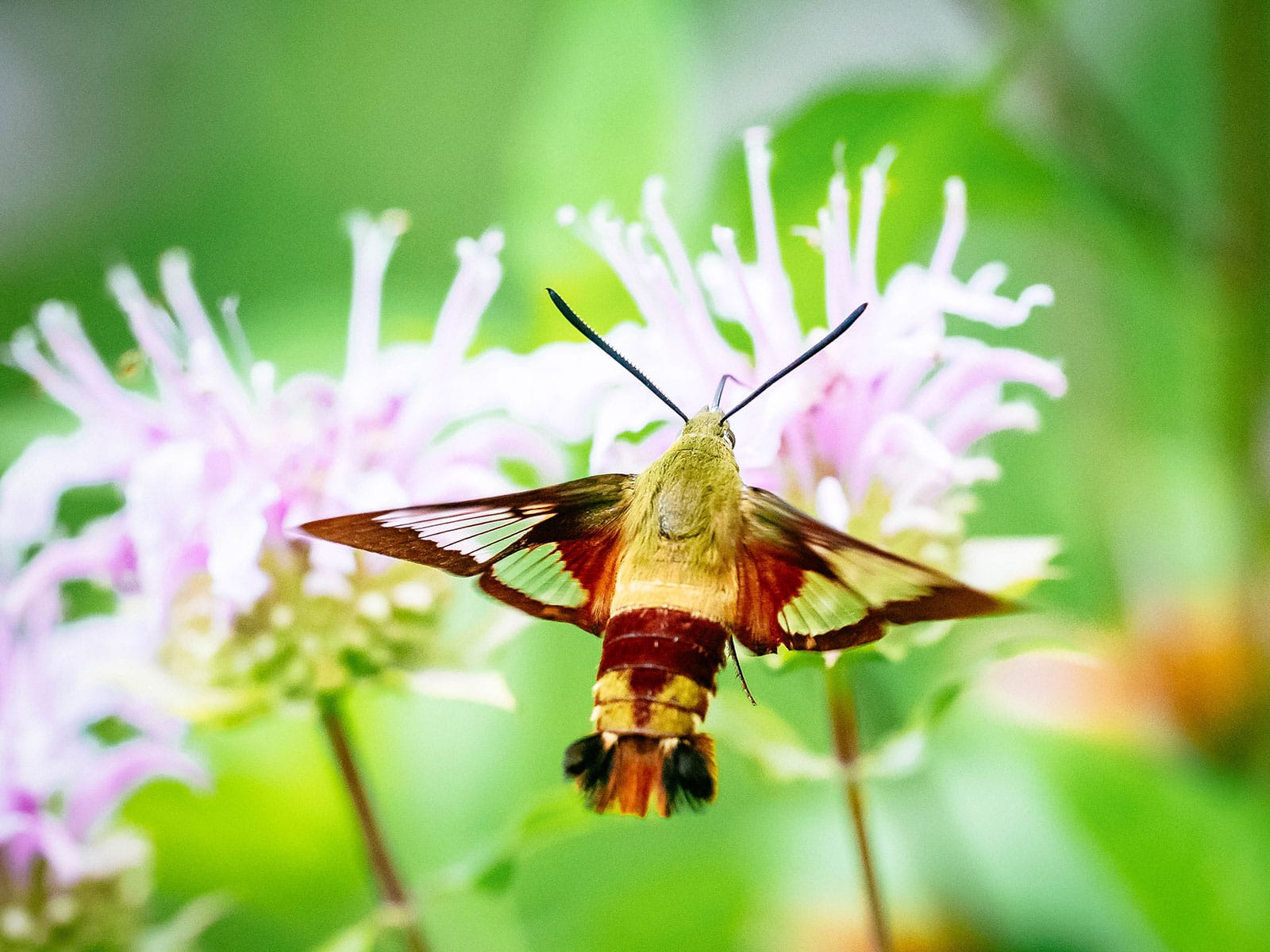
Moths of the genus Hemaris, the clearwings, are also referred to as hummingbird moths. It’s not difficult to see why. If you happen to spot one of these hovering next to a flower from the corner of your eye, it really is likely you’ll confuse it with a hummingbird.
Read more: How to identify common hummingbirds in your garden
Unlike saturniid moths, members of the family Sphingidae such as this one do eat in their adult form. They have long proboscises (tongues) that they can unroll to suck nectar from tubular flowers. They do so while hovering in mid-air and quickly flitting from one flower to the next.
Hummingbird clearwings are common in gardens, especially if you grow pink or purple flowers. They mostly occur in the eastern US, although they also sometimes pop up in the northwest. The species is migratory, moving from north to south yearly in search of warmth and food.
Caterpillar: Green in color with spots and a lighter, horizontal line down its back, plus a characteristic “tail.” It eats the leaves of various plant species, including cherry trees, hawthorn, and honeysuckle.
Did you know?
In the eastern and central US, plus all of southern Canada, you may also come across the snowberry clearwing. This beautiful Hemaris species is also called the bumblebee moth, as its furry body and pattern make it look just like a bumblebee.
Polyphemus moth (Antheraea polyphemus)
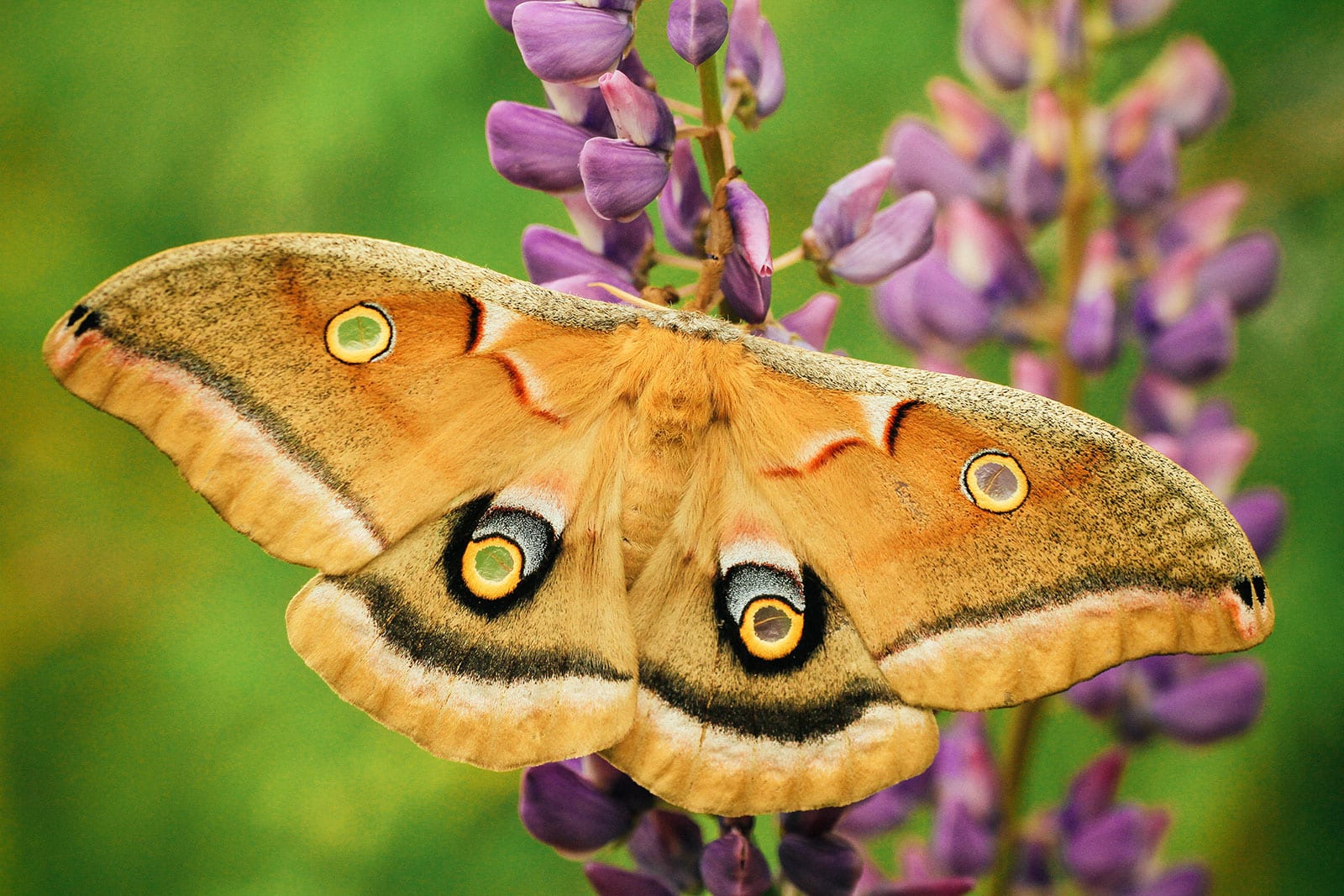
Brown camouflage colors don’t have to equal boring. Moths prove this over and over, but one of the species that does it best is the large polyphemus moth. This saturniid moth has a wingspan of up to 6 inches and features a lovely medley of tan to brown coloration, interspersed with striking pink markings and two large (plus two small) eyespots.
This moth is found throughout the United States and much of Canada, although it’s most common in the east. Its adult lifespan is about a week, although in most regions, two generations per year are produced.
Caterpillar: Green in color with thin, vertical lines and sparse hairs. It eats a variety of tree foliage, but prefers elm, birch and willow.
Tiger moth (Arctia caja)
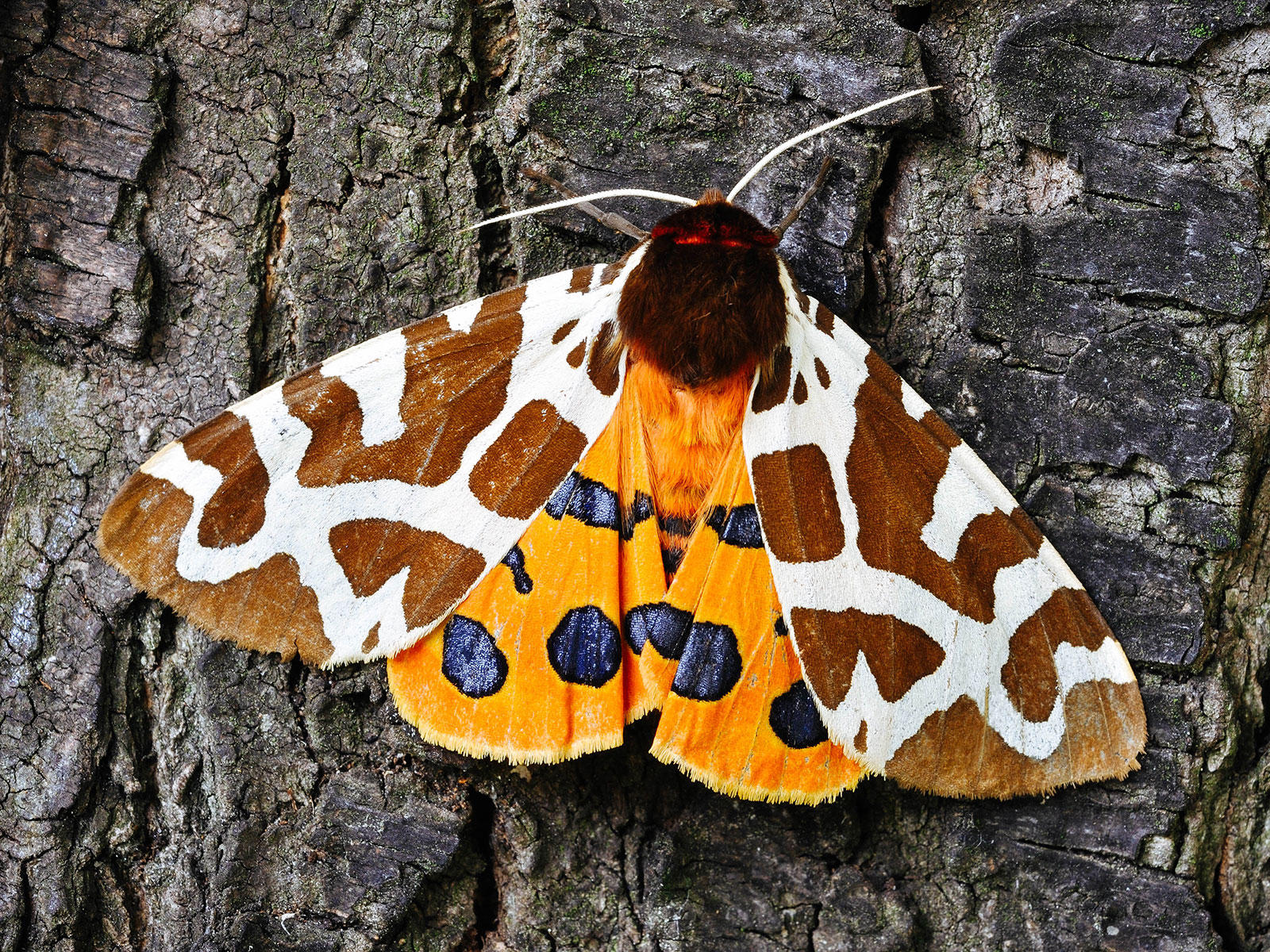
Ever heard of startle coloration? It’s a self-defense technique that’s common in moths. Basically, their wings look inconspicuous in their closed position. When they’re approached by a predator and fly off, the wings open to reveal an unexpected color and/or pattern.
The aforementioned polyphemus moth uses its big eyespots, which resemble owl eyes, to startle predators. An excellent choice, but I wouldn’t consider it the champion of startle coloration: that honor goes to the tiger moth, Arctia caja.
A resting tiger moth is already quite a sight to see, with a sort of giraffe-like blocked pattern of dark brown and cream coloration. When it opens its wings, though, a flash of bright orange is uncovered! A real sight to see, and a clear sign to any predator that it’s toxic and doesn’t make for good eating.
Tiger moths are found in the northern, central, and western US, where they prefer cool climates.
Caterpillar: Called the wooly bear caterpillar, and it is indeed very hairy. Caterpillars are orange on the bottom and dark brown on top, with small white dots. They eat toxic plants in order to become toxic themselves.
Did you know?
Fuzzy moths are harmless and can be handled fine (although they’re fragile and you should keep it to a minimum). Fuzzy caterpillars are a different story: their hairs usually cause skin irritation. As soft as they look, it’s best to leave the wooly bears be!
Cecropia moth (Hyalophora cecropia)
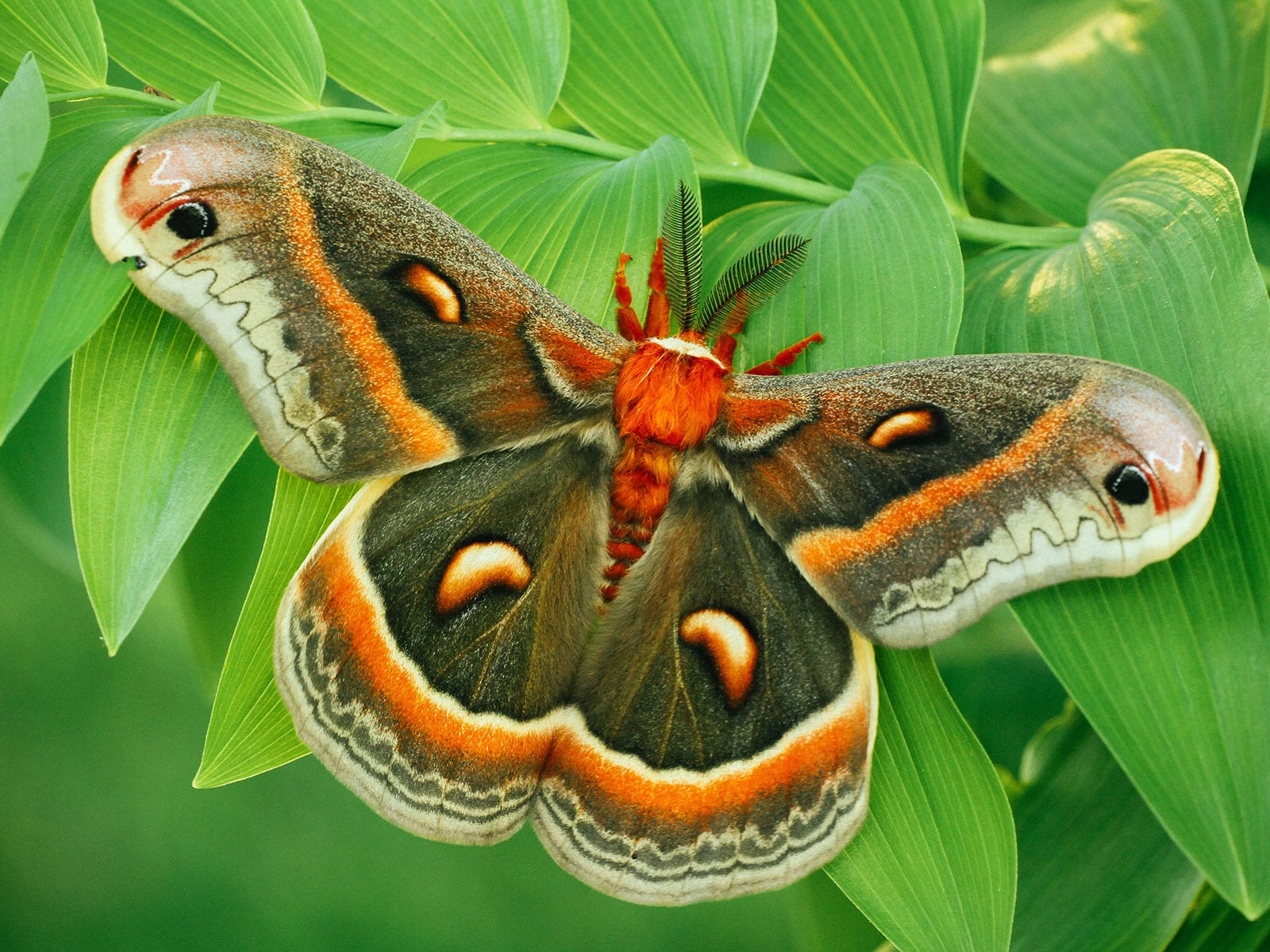
Wowza! Say hi to the largest moth species in the US, the cecropia moth. With a wingspan of up to 7 inches, this spectacular species is a real treat to find in your garden. Another silkmoth, it sports a pretty pattern of different shades of brown and tan on its huge wings.
The cecropia moth is found mostly in the eastern US (sorry westerners—as you may have noticed, you guys just don’t have as many moths!) and up into Canada. It lives around two weeks, longer than some other silkmoths, but only one generation per year is produced.
Caterpillar: Bizarre! It’s green to yellow or brown and clearly segmented, with colorful, black-spiked bumps in shades of red, yellow and blue all over its body. It mostly eats maple leaves.
Io moth (Automeris io)

Holy eyespots, Batman! Many moth species have eye-like patterns on their wings in order to confuse predators, but the io moth has taken this concept to a whole new level. Both the yellow males and the reddish-brown females sport large black spots with a dash of white in the center. The spots are surrounded by striking reddish-pink coloration.
Found in the eastern to central United States and southern Canada, this saturniid moth isn’t very fussy about habitat. It can be found everywhere from forests to gardens, so as long as you’ve got some trees for the caterpillars to feed on, it should be easy enough to attract to your backyard.
Caterpillar: Brown to green with spines. Don’t touch it if you don’t want a painful rash! It eats the leaves of various tree species, including mulberry, willow, and many more.
Promethea moth (Callosamia promethea)
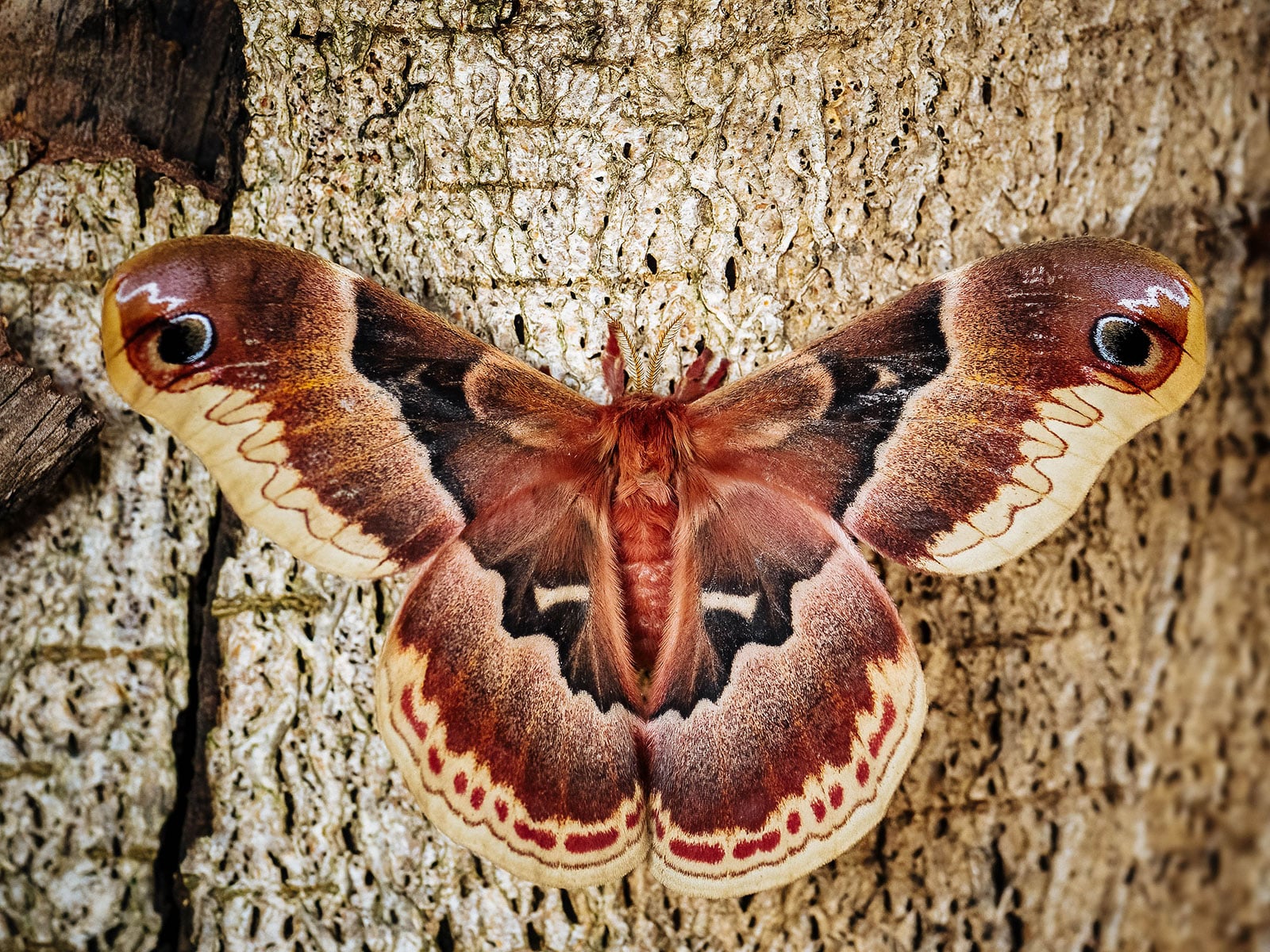
Let’s keep it going with the saturniid moths—there are just so many gorgeous species out there! Another stunner for this list is Callosamia promethea, better known as the promethea moth or spicebush silkmoth, which is naturally found in the eastern US.
Like the aforementioned io moth, the promethea moth is distinctly sexually dimorphic. The females sport a variety of beautiful reddish-brown and tan colors, including two eyespots. The males, on the other hand, mimic a poisonous butterfly (the pipevine swallowtail butterfly) for protection. Their wings are dark brown with lighter, patterned edges.
Related: Have you seen any of these butterflies in your garden?
Caterpillar: Green with dots along its side, as well as yellow and red protuberances. They eat various plants in the rose, olive, and laurel families.
Did you know?
Strangely, male and female promethea moths aren’t active at the same time. The females are mostly nocturnal, while the males fly during the day. They manage to find each other in the early evening to mate, though.
Imperial moth (Eacles imperialis)
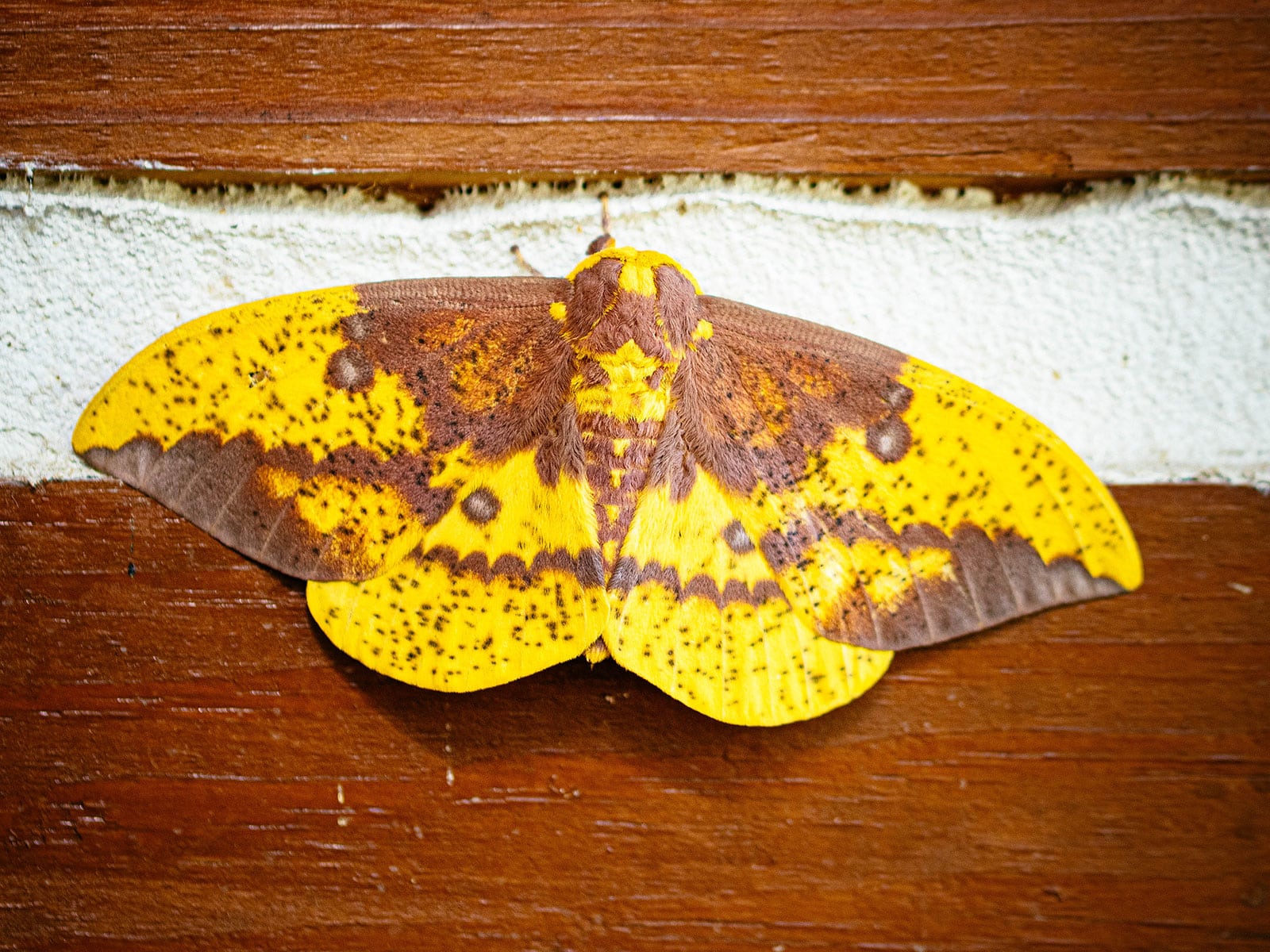
When you first spot an imperial moth, it can be difficult to figure out what advantage its unusual yellowish and brown mottled coloration could possibly offer. But as we saw with the rosy maple moth, which imitates maple seeds, there’s always a reason to be found. In this case, the imperial moth perfectly mimics a decaying leaf for camouflage purposes!
Found mostly in the eastern US, a small part of southeastern Canada and far into Latin America, this saturniid moth grows to an impressive wingspan of almost 8 inches. It inhabits forests, both deciduous and pine, so you’re most likely to find one in your yard if you live in a wooded area.
Caterpillar: (Reddish) brown to green, with dots running along its sides. Slightly hairy and with yellowish-to-brown protuberances. They eat the leaves of various trees, including conifers like pines and deciduous species such as maple.
Did you know?
There’s a whole bunch of imperial moth subspecies. You can find individuals ranging from almost entirely yellow to totally brown—and everything in between.
Pacific green sphinx moth (Proserpinus lucidus)
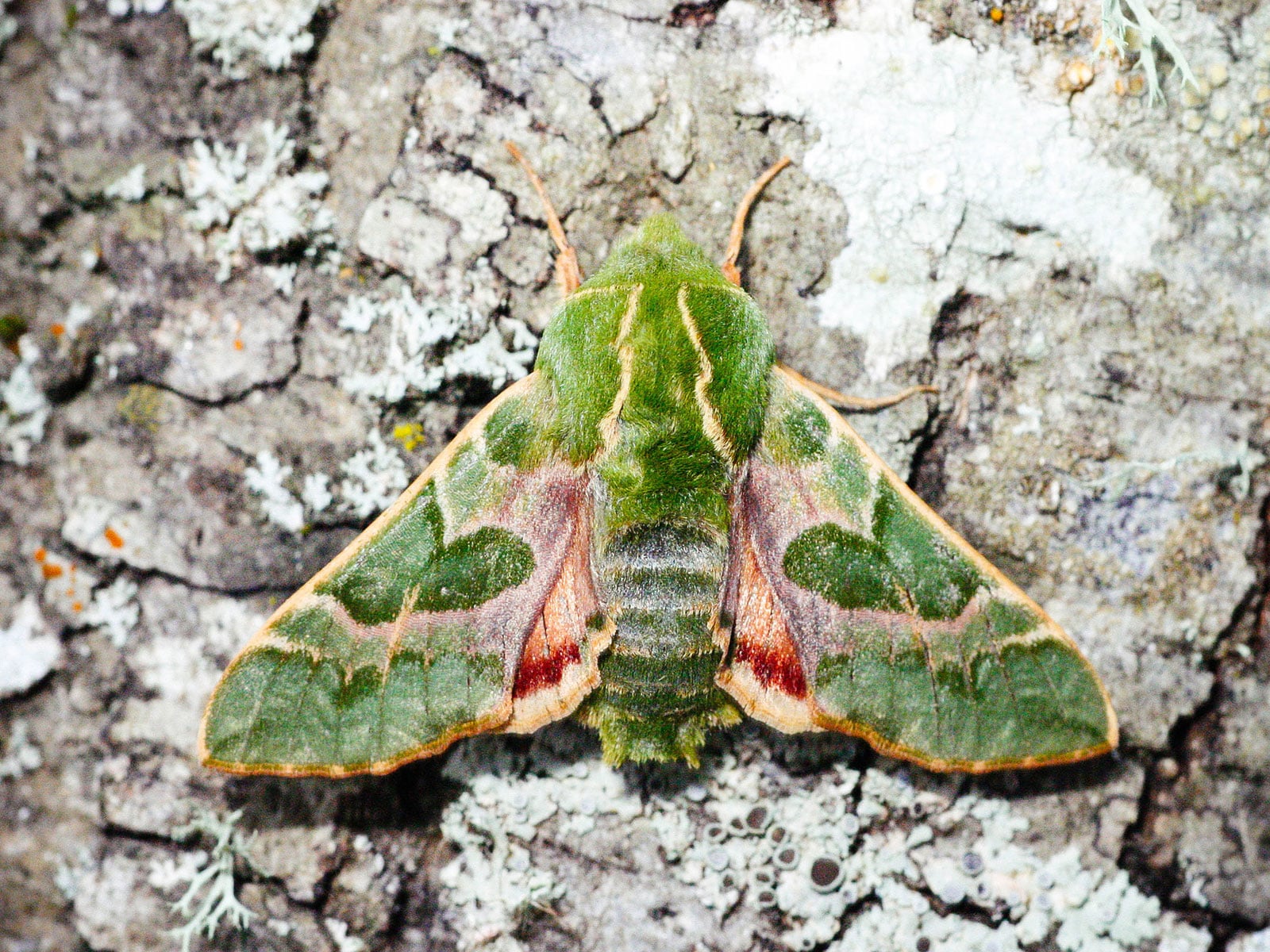
Also known as the bear sphinx moth, this nocturnal beauty has a short, stout body and a wingspan of about 2 inches. Its forewing is densely covered in bright green to olive green scales with tan margins, and its hindwing is rosy pink to brown in color. It almost looks like a jewel that Cleopatra would have worn!
As its name suggests, the Pacific green sphinx moth is found throughout the Pacific coast region (Washington, Oregon, Idaho, and California) and flies in early spring. It can be seen in elevations ranging from 200 feet to 3,500 feet, where it prefers sagebrush steppe, mixed grasslands, ponderosa pine forests, and juniper woodlands—if you live in (or on the edge of) any of these habitats, you’re bound to find one.
Caterpillar: Green and plump with black dots on each segment along its sides. It feeds on various species of the Onagraceae family, including Clarkias, evening primrose, and sundrops.
White-lined sphinx moth (Hyles lineata)
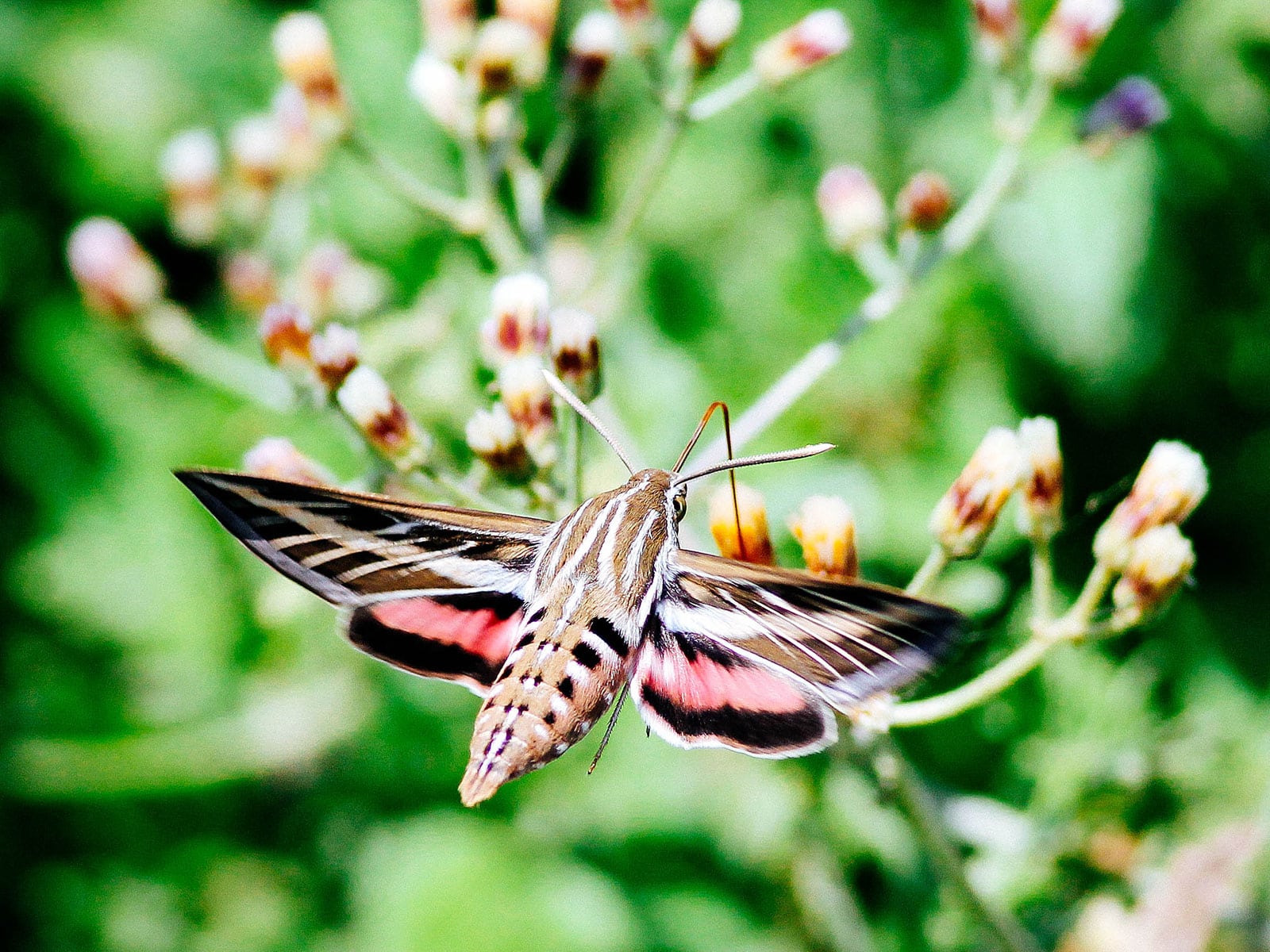
Here’s another stunning moth for inhabitants of the western US! The white-lined sphinx moth is related to the hummingbird clearwing moth we discussed earlier. Rather than transparent wings, though, it boasts a pretty pattern of brown, tan, and pink.
This species is naturally found throughout all of the US, as well as in some of Canada and down to Central America.
Unlike saturniids, sphinx moths do eat as adults, and they have a huge taste for flowers. They’re great pollinators that are easy to attract to your yard with flowers like lilac, honeysuckle, clover, and much more. It’s fascinating to see them hovering perfectly still while they suck nectar from a bloom!
Caterpillar: Large and green, with spots down its sides and a horn. It likes a wide range of leaves, including those of nightshades like tomato, as well as apple and elm trees.
Giant leopard moth (Hypercompe scribonia)
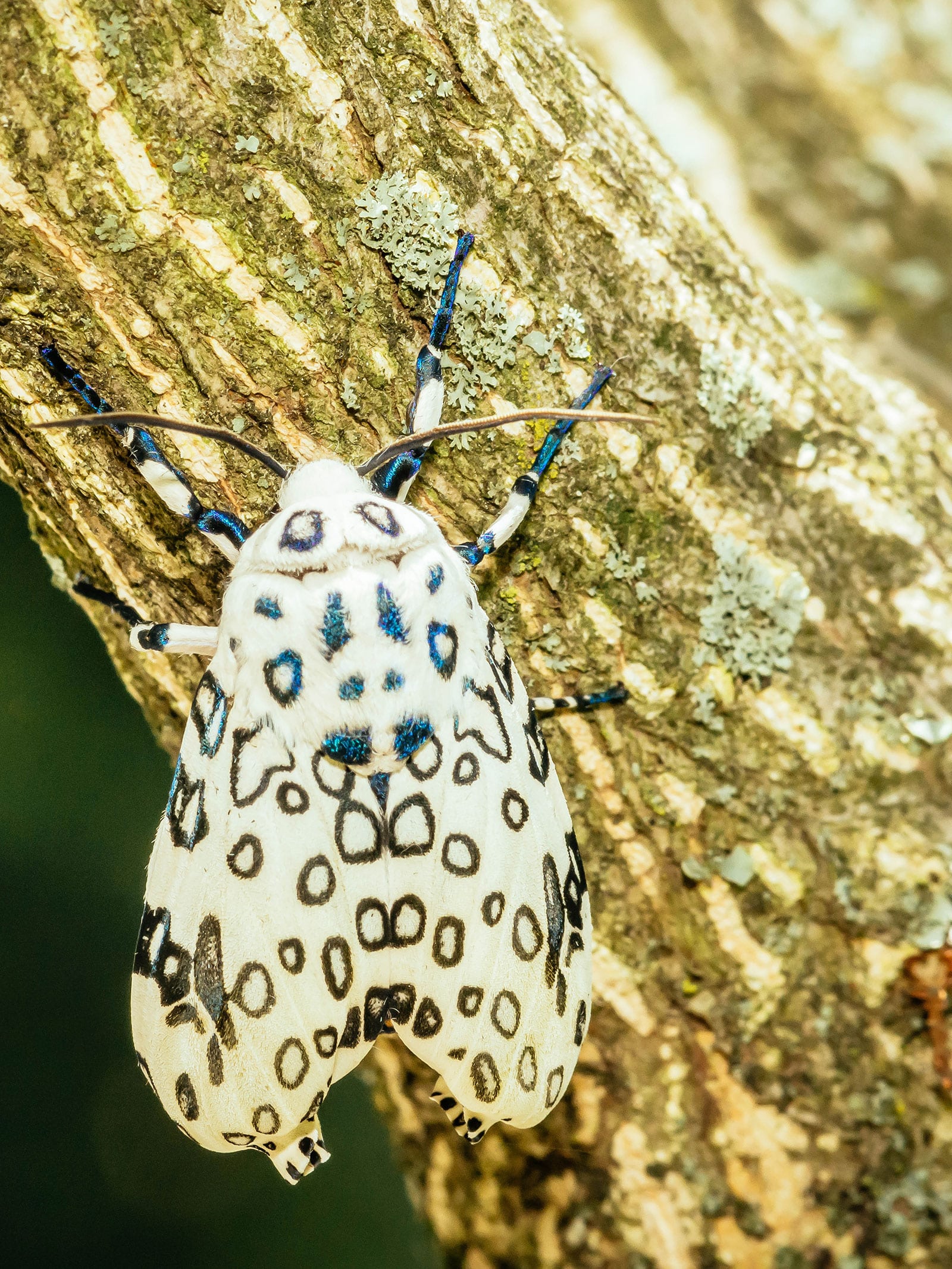
With a wingspan of up to 3 inches, the giant leopard moth is indeed a giant among the members of its subfamily, Arctiinae (the tiger or lichen moths). Its large size, combined with its snow leopard coat, make this one easy to spot in your garden. It sports a white base covered with blackish-blue rings and spots.
Native to eastern North America and all the way down into Colombia, the giant leopard moth inhabits a variety of habitat types, including forests, open meadows, and backyards. Like the saturniid moths, the adults don’t eat, so their lifespan is very limited.
Caterpillar: Of the “woolly bear” type, with black bristles and red segments that become visible when it curls up into a defensive ball. Unlike many similar caterpillars, it’s not venomous. It likes a wide variety of plants, from trees to garden weeds.
Did you know?
The giant leopard moth overwinters in its caterpillar form, usually wedged under some tree bark for protection. This isn’t an unusual tactic, although different species may overwinter as eggs, pupae, or even adults. Yet others, including some sphinx moths like the hummingbird clearwing, are migratory.
Regal moth (Citheronia regalis)
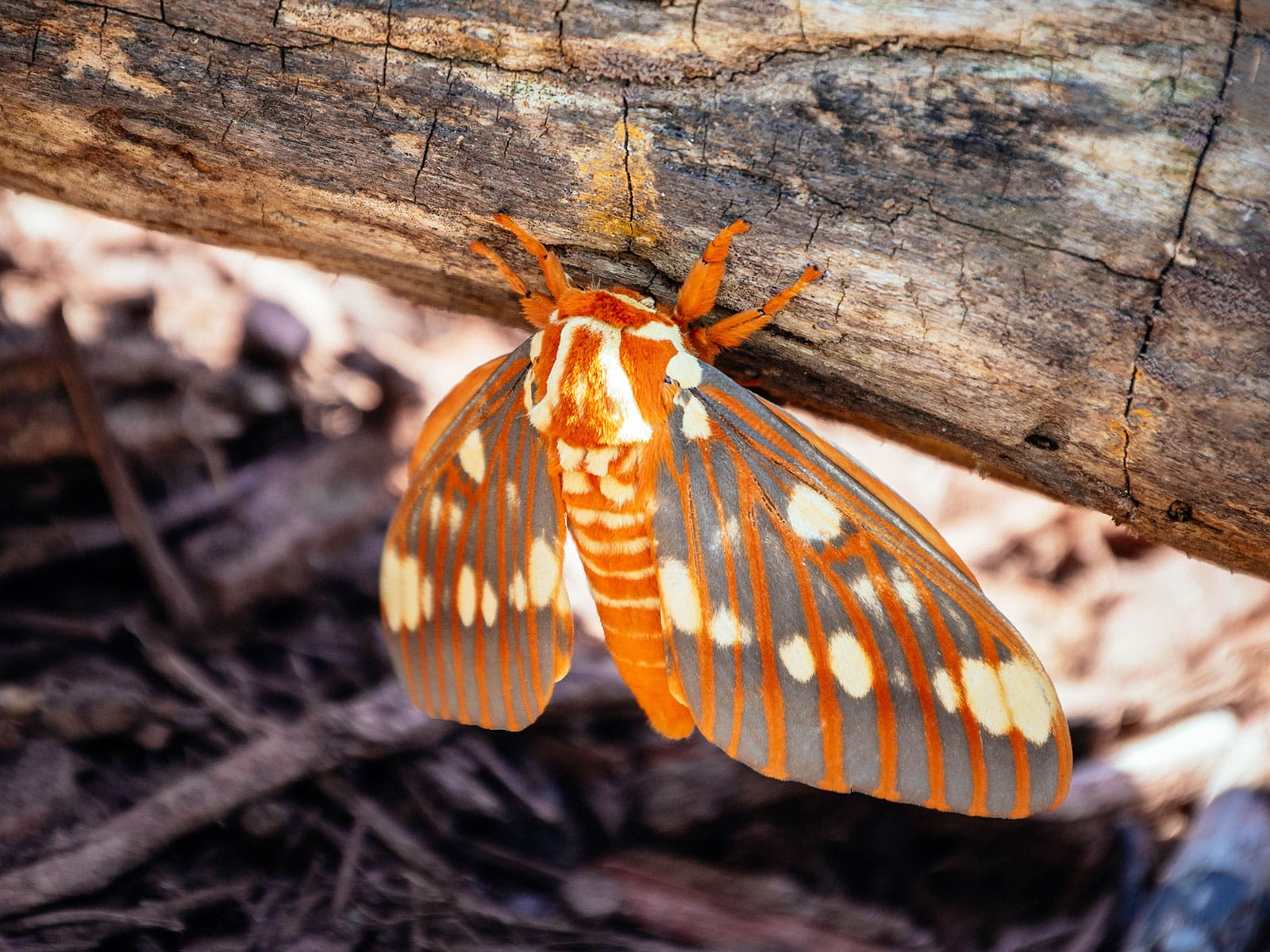
Regal indeed! Another head-turning saturniid moth, Citheronia regalis also happens to be one of the largest in North America, reaching a wingspan of up to 6 inches. The species has grayish-green wings with fiery reddish-orange stripes and yellow spots, which are also present on the fuzzy body.
This moth is mostly found in the southeastern United States, although it can occasionally be spotted as far north as southern Michigan. Since their caterpillars eat the leaves of specific tree species, they mostly pop up in forested regions.
Caterpillar: The luna moth mentioned at the start of this post may be the most spectacular moth on the list, but this is easily the most striking caterpillar. Known as the hickory horned devil, it’s large and pale green with black bristles. It sports up to ten reddish-brown horns right behind the head. Wacky, although the horns aren’t actually venomous.
The hickory horned devil likes hickory (who would have thought!), but it also eats sweetgum, sumac, and more.
Oleander hawk moth (Daphnis nerii)
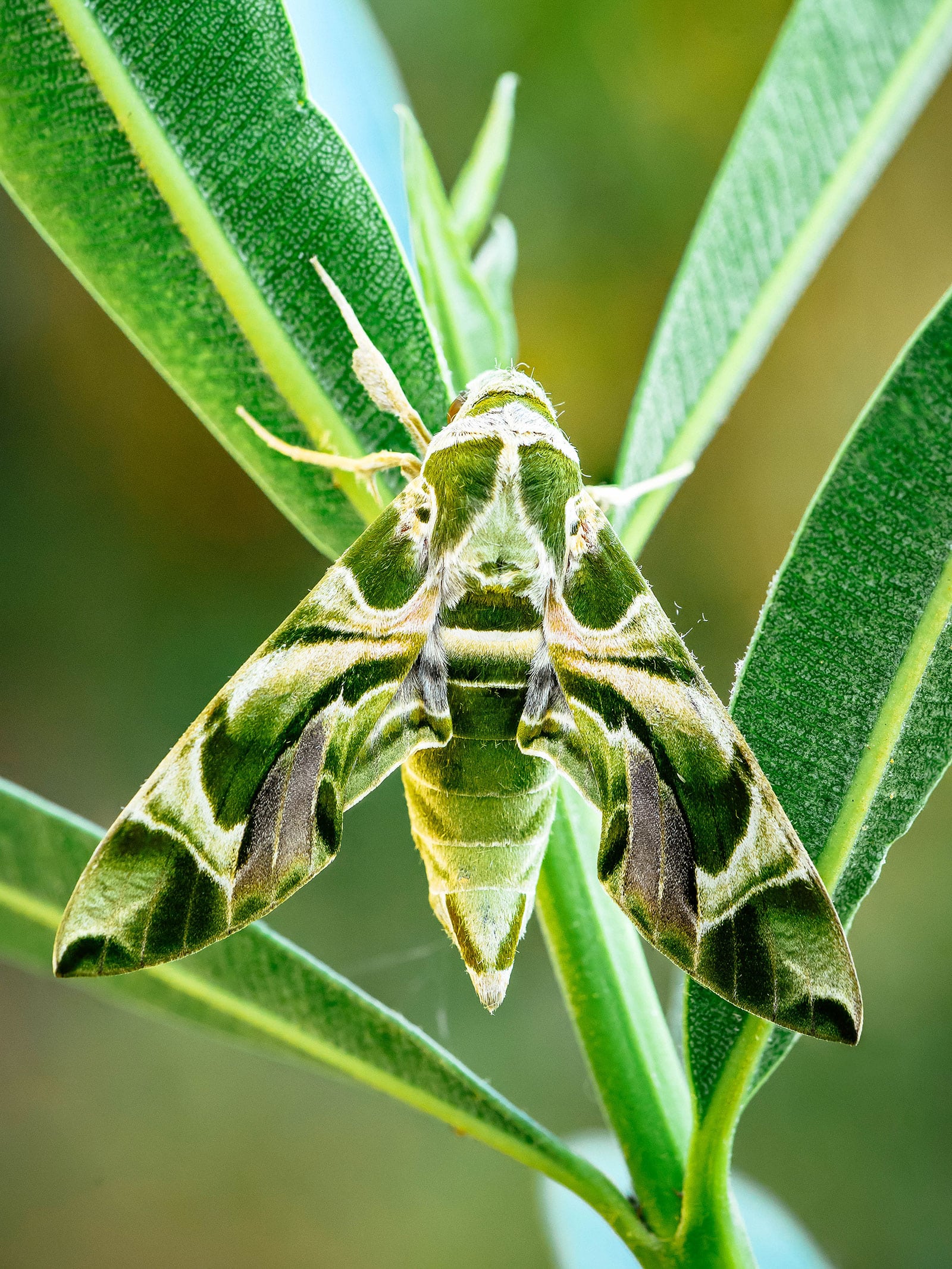
This remarkable moth has a large wingspan that stretches up to 4 inches, with tan eyespots toward the front. Its wings are a patchwork of green colors, from light green to olive green to forest green, interspersed with bands of white and tan. The distinctive pattern almost resembles military camouflage, inspiring its other name: army green moth.
While the oleander hawk moth is native to Asia, Africa, and parts of Europe, it arrived in Hawaii in the 1970s—the only place in North America where it’s found. The adult moths are especially active during twilight hours as they feed on fragrant flowers like honeysuckle, jasmine, and petunias.
Caterpillar: Plump and green with two blue eyespots and a pattern of tiny white and blue dots (ringed in black) down its sides. Oleander hawk moth caterpillars are partial to oleanders, whose toxic leaves have no effect on them.
Pandora sphinx moth (Eumorpha pandorus)
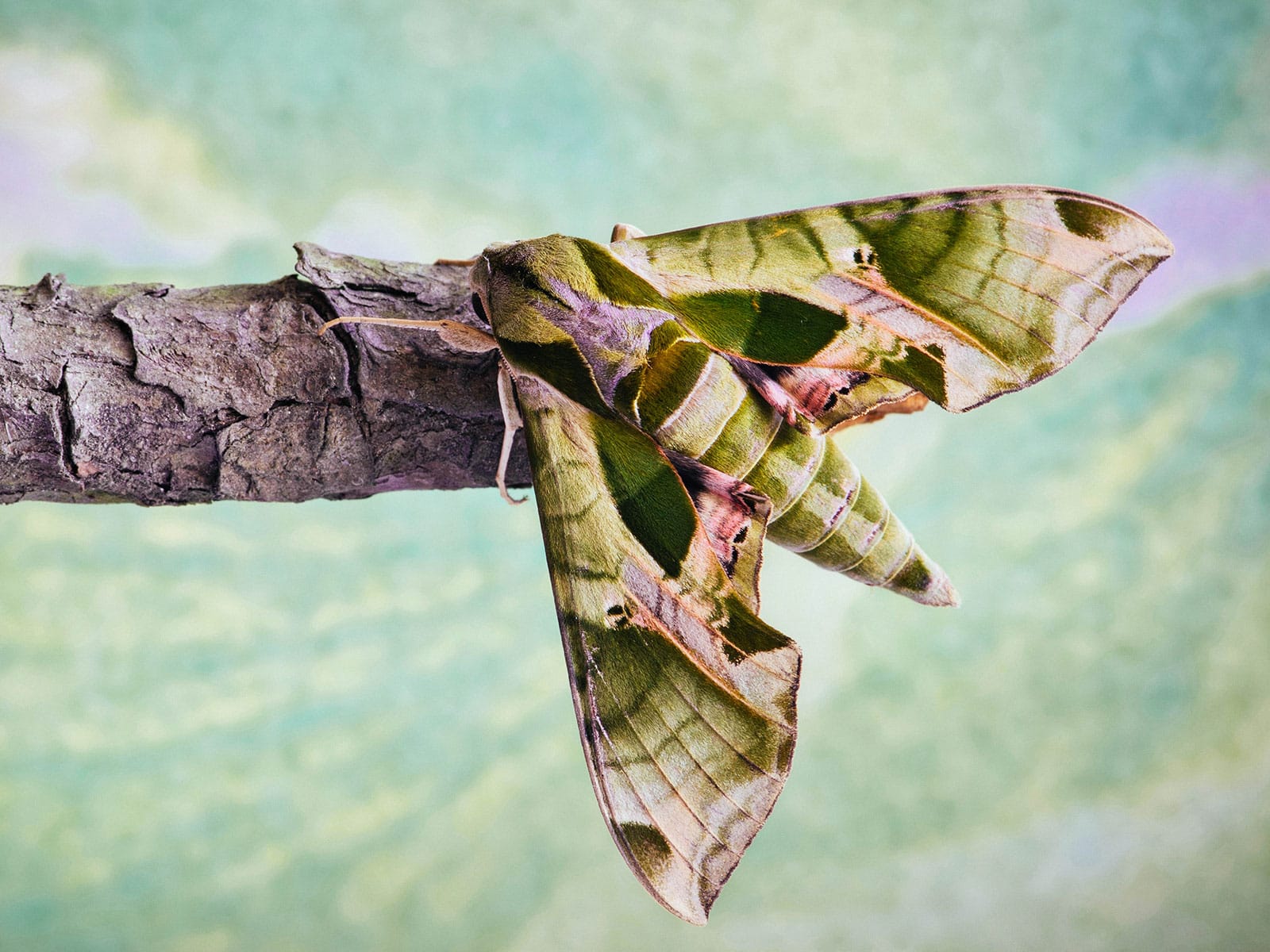
The pandora sphinx moth is similar in looks to the aforementioned oleander hawk moth. Take a close look, though, and you’ll notice a few differences. First and foremost, pandoras lack the oleander hawk moth’s characteristic eyespots. The green pattern on their wings can be described as perhaps more “blocky.”
This sphinx moth also has a wider range, distributed throughout southeastern Canada and the eastern US.
Caterpillar: Looks like a standard hornworm, except it’s a reddish-brown in color rather than green. It has eyespots down its sides and likes plants in the grape family Vitaceae.
Spotted Apatelodes (Apatelodes torrefacta)
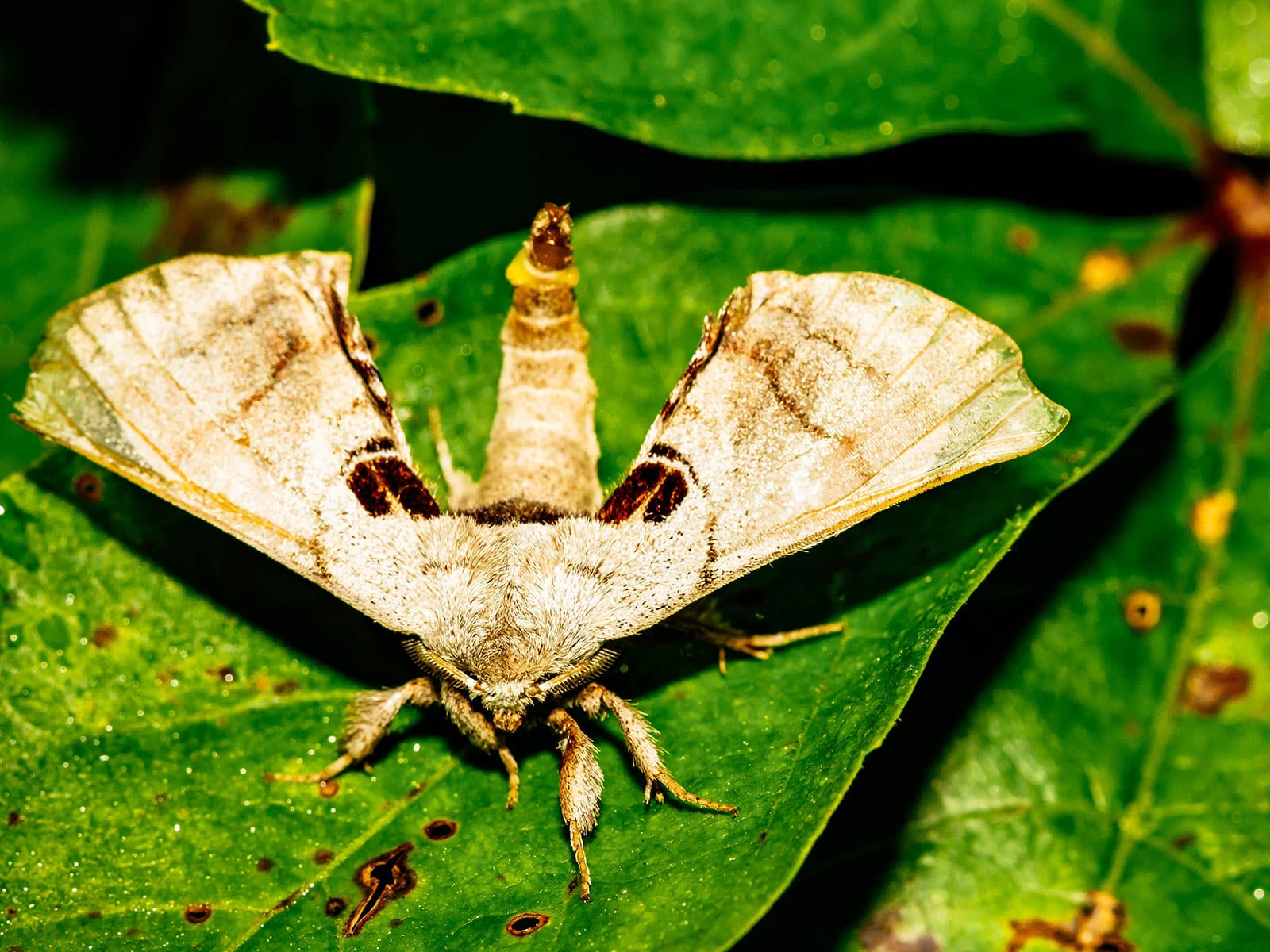
The spotted Apatelodes moth is an unusual-looking species with elongated, triangular-shaped wings in the resting state. It’s highly camouflaged with grayish-brown colors and some spotting, which can make it almost invisible against a background of tree bark.
Native to southern Canada and the eastern to central US, this moth (and the other members of its family, Apatelodidae) can be recognized by an interesting behavior that doesn’t appear to be fully understood yet. Namely, it tends to lift its abdomen so its “butt” sticks up. Maybe it’s a defensive thing, maybe it aids in releasing pheromones—who knows!
As with some of the other moths on this list, the adults don’t eat.
Caterpillar: So fuzzy and yellow it almost looks fake, especially with those black horns sticking out! Careful, apparently its hairs can burn. It eats ash, maple, oak, and trees in the cherry family.
Sources:
Barber, J. R., Leavell, B. C., Keener, A. L., Breinholt, J. W., Chadwell, B. A., McClure, C. J., … & Kawahara, A. Y. (2015). Moth tails divert bat attack: evolution of acoustic deflection. Proceedings of the National Academy of Sciences, 112(9), 2812-2816.
Stevens, M. (2005). The role of eyespots as anti-predator mechanisms, principally demonstrated in the Lepidoptera. Biological Reviews, 80(4), 573-588.
Tartaglia, E. S. (2013). Hawkmoth-flower interactions in the urban landscape: Sphingidae ecology, with a focus on the genus Hemaris. Rutgers The State University of New Jersey, School of Graduate Studies.
Wagner, D. L. (2012). Moth decline in the northeastern United States. News of the Lepidopterists’ Society, 54(2), 52-56.
















I think all these moths have their own unique beauty and grace.